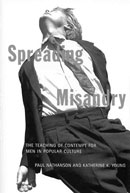
Spreading Misandry: The Teaching Of Contempt For Men In Popular Culture
Paul Nathanson and Katherine Young
McGill-Queen’s University Press
$39.95
cloth
348pp
0-7735-2272-7
It is not the subject here that is objectionable. Today’s generation of men is the first to be raised without the expectation of becoming cannon fodder in some glorious cause; the first to forge an identity beyond the primacy of the male breadwinner; and one of the first to contend with the fallout of feminism. As such, male identity in a post-feminist world emerges as a necessary avenue of inquiry. Unfortunately, this inquiry resorts to the very tactics it purports to decry: divisive rhetoric, dualistic thinking, and blame, blame, blame.
So, who or what is culpable? Well, feminism, of course – specifically ideological feminists, who, with their “relentless hostility towards men as a class of enemy aliens,” have brainwashed the populace into the belief that “the only good man is either a corpse or a woman.” The result, Nathanson and Young contend, is a level of anti-male sentiment that justifies comparison to Jewish persecution. By way of evidence, they wade through the cultural detritus of our allegedly “gynocentric” society, lamenting the deep psychic wounds inflicted upon men by such devilish propaganda as Beetle Bailey, Beavis and Butt-Head, and the greeting card industry.
What are the weapons wielded in this war? Well, as one example suggests, repeated mockery of man’s inability to pick up his socks has finally taken its toll. In another much maligned instance, an episode of Home Improvement, the authors object to the identification of a “souped-up lawn mower” as a “bad boy”: “The implications are that technology is associated not only with ‘boys’ but also with ‘badness.'” When the show’s star anoints his TV offspring’s face with grease, the authors lament the “stereotype…of the allegedly male penchant for dirt.” Ultimately, they denounce such slander with the sort of hyperbole that would embarrass most self-respecting film studies students: “Marilyn French, the author of Beyond Power, a compendium of every conceivable way in which women are superior to men, could have written [this] episode.”
Glaringly absent from this litany of alleged cultural crimes is any discussion of those responsible for creating such images. In a study entitled The Celluloid Ceiling, Martha M. Lauzen of San Diego State University surveyed the status of female employment in the top 250 grossing films of the year 2000. The statistics are startling: for the third year in a row, women comprise a mere 17% of all executive producers, producers, directors, writers, cinematographers, and editors. The numbers for the television industry are similarly abysmal. Meanwhile, every comic strip cited is penned by a man (or men); and, of some 30 films denounced by the authors as misandric or “quasi-misandric”, fewer than half were written or co-written by women, while a mere handful boasted female directors. Allotting blame to feminism, then, seems misguided.
Spreading Misandry is not addressed to skeptics. Few female readers are likely to be swayed by the idea that “doing housework presents a real problem… in connection with masculine identity”; that “many women are reluctant to say ‘yes’ [to sex] without some coaxing”; and that modern notions of marriage are inherently unequal. At best Spreading Misandry bolsters the opinions of those who already believe. Its most damaging aspect, therefore, is what it says to men of dissenting belief. Within a gynocentric environment, the authors aver, the only acceptable means of asserting male identity is conversion – to become an “honourary woman.” Thus, they negate the identity of those who define themselves as caring and involved fathers, companionate husbands and partners, responsible and informed citizens; those who, though they may not identify with feminism, recognize its source. Such men, Spreading Misandry seems to say, are either dimwitted rubes, traitors to their own kind, or- worse yet – not even men. mRb






0 Comments